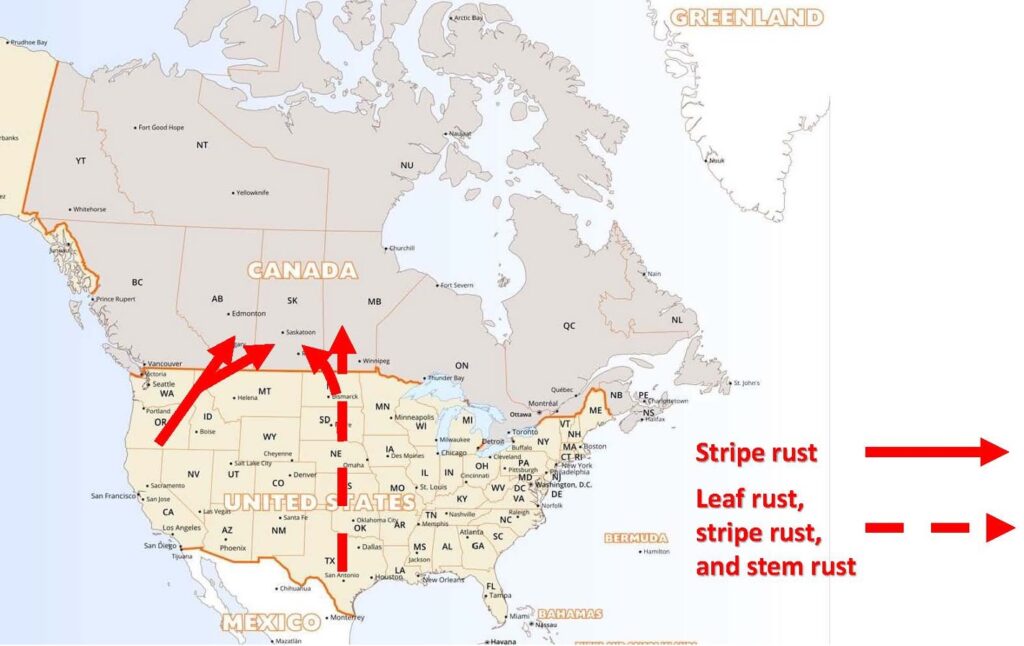Section Title
Prairie Cereal Rust Risk Levels
- Wheat
Cereal rusts are a threat to Prairie wheat and barley production annually. Cereal rusts include leaf rust (Puccinia triticina), stem rust (Puccinia graminis) and stripe rust (Puccinia striiformis). All three rust pathogens can cause widespread devastation and crop loss, especially in wheat. Therefore, all pathogens are considered priority-one wheat diseases in Canada, while stem rust is the only rust pathogen considered a priority one-disease in barley (Aboukhaddour et al. 2020).
Rust species don’t typically overwinter in Manitoba, except for in a few instances, while overwintering of stripe rust is more common in the western Prairie region. Rust spores move into Manitoba from northern Mexico and the southern United States annually by prevailing winds – this is sometimes referred to as the “Puccinia Pathway” (Figure 1). The rust pathogens sequentially infect host plants, moving northward. There are two main “corridors” or source regions through which rust spores travel to Manitoba: The Texas-to-Oklahoma region and the Kansas-to-Nebraska region. Both regions are a major source of inoculum to Manitoba and central to eastern Saskatchewan for leaf rust, stem rust and stripe rust. The Pacific Northwest is another source region, but it is a more important source of inoculum for the western Prairie provinces, such as Alberta and central to western Saskatchewan. More information on cereal rust disease biology and life cycles can be found here, here and here for leaf, stem and stripe rust, respectively.

Figure 1. Image of the “Puccinia Pathway”, depicting how rust spores move up from Mexico and the Southern United States to Manitoba (Image: Provided by Dr. Kelly Turkington).
Crop rotation and host plant volunteer control have little impact on rust control and severity, compared with stubble-borne diseases such as Fusarium head blight or leaf diseases. This is due to rust spores being blown into Manitoba annually from the southern United States and Mexico. Therefore, the management practices available to combat rust infections are limited. Practices include:
- Growing a variety with high levels of cereal rust resistance. Check Seed Manitoba for resistance levels of current varieties.
- Timely application of foliar in-crop fungicides.
- Seeding early might also reduce disease severity and incidences for leaf and stem rust, but much depends on disease development in the United States and the prevailing winds.
Cereal Rust Risk Levels
Understanding disease risk is important when it comes to making management decisions. The Prairie Crop Disease Monitoring Network (PCDMN) publishes a weekly cereal rust report from early May to late June. These reports are a warning system, indicating the cereal rust risk for Prairie farmers. The reports indicate the overall Prairie cereal rust risk levels (low, medium, high) using “speedometer” graphics (Figure 2). The graphics also outline the current risk associated with all factors that contribute to the overall cereal rust risk levels. Cereal rust risk reports can be found here.
By using this information, plus varietal disease resistance levels, a cereal rust risk can be established for your crop. This information is beneficial when determining scouting frequency and crop monitoring intensity.
Figure 2. Prairie Cereal Rust Risk Dashboards developed by the PCDMN for the Pacific Northwest (left), Texas-Oklahoma (centre) and Kansas-Nebraska (right) source regions. Dashboards are from June 7-13, 2023.
Risk levels are determined using backward wind trajectories. Backward trajectories follow air parcels moving over at-risk areas in the Canadian Prairies over the previous five-day period, forecasting where the air parcels came from (PCDMN 2023). PCDMN identifies wind trajectories that had the ability to move spores from epidemic source areas to the Canadian Prairie provinces. Typically, as wind events increase, so does cereal rust risk, especially with significant rust epidemics in source U.S. regions (PCDMN 2023). More information on wind trajectories and how they are used to develop cereal rust risk levels can be found here.
References
- Aboukhaddour R, Fetch T, McCallum BD, Harding MW, Beres BL, Graf RJ. 2020. Wheat diseases on the prairies: A Canadian story. Plant Pathology. 69(3): 403-597.
- [PCDMN] Prairie Crop Disease Monitoring Network. 2023. An introduction to cereal rust risk and wind trajectories from the USA. [cited 2024 April 29]. Available from: https://drive.google.com/file/d/1loDWm_QhyEBlsbfJPV9YE99S1n1Kxkty/view












